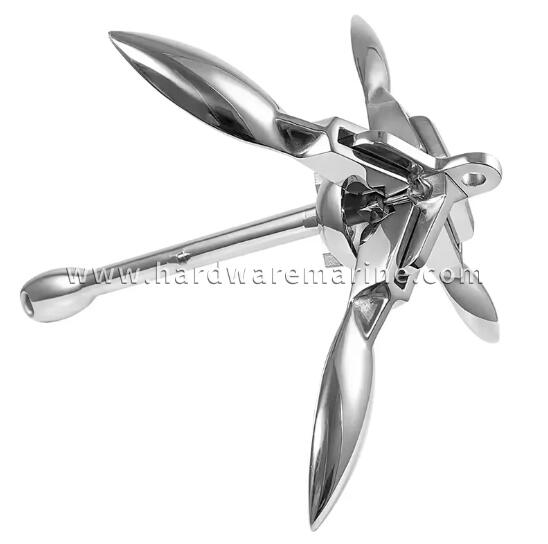The Science Behind the 316 Stainless Steel Grapnel Anchor: Why It’s the Best Choice for Your Boat
2024-09-02
When it comes to boating, the anchor is one of the most critical pieces of equipment. It’s your primary tool for ensuring your boat stays put, whether you’re stopping for a quick swim, fishing, or waiting out a storm. Among the various types of anchors available, the 316 Stainless Steel Grapnel Anchor stands out due to its combination of robust design and high-quality material. In this blog, we'll explore the science behind the 316 stainless steel grapnel anchor and why it’s considered one of the best choices for boaters.
Understanding the Grapnel Anchor Design
The grapnel anchor has a unique design that sets it apart from other types of anchors. Let’s break down the key components:
1. Flukes: The grapnel anchor typically has four or more flukes (prongs) that are designed to hook onto various surfaces, such as rocks, coral, or the seabed. This makes it particularly effective in environments where other anchors might struggle to gain a hold.
2. Shank: The central shaft, or shank, of the anchor connects the flukes to the anchor line (rode). In a grapnel anchor, the shank is often designed to fold, making the anchor compact and easy to store.
3. Versatility: The grapnel anchor’s design allows it to work in a variety of seabeds, including rocky, sandy, and muddy bottoms. This versatility makes it a go-to anchor for boaters who explore different waters.
Why 316 Stainless Steel? The Material Advantage
The choice of material is crucial in anchor design, especially for marine applications. The 316 stainless steel used in grapnel anchors offers several advantages:
1. Superior Corrosion Resistance: Stainless steel is known for its resistance to corrosion, but 316 stainless steel goes a step further. It contains molybdenum, an alloying element that enhances its ability to resist pitting and crevice corrosion, particularly in saltwater environments. This is essential for an anchor that is constantly exposed to harsh marine conditions.
2. High Tensile Strength: Anchors need to withstand significant forces, especially when holding a boat in place during strong currents or high winds. 316 stainless steel provides the high tensile strength needed to endure these forces without deforming or breaking
3. Durability: The durability of 316 stainless steel ensures that the anchor will last for many years, even with regular use. This makes it a cost-effective choice in the long run, as it reduces the need for frequent replacements.
4. Non-Magnetic Properties: Unlike some other metals, 316 stainless steel is non-magnetic, which means it won’t interfere with electronic devices or compasses on board. This is particularly important for navigation and safety equipment.
How the Grapnel Anchor Performs in Different Conditions
The effectiveness of the grapnel anchor comes down to how well it performs in various anchoring conditions:
1. Rocky and Coral Seabeds: The grapnel anchor’s flukes are designed to catch on rocks and coral, providing a secure hold in environments where other anchors might slip. This makes it ideal for coastal waters with rocky bottoms.
2. Sandy and Muddy Bottoms: While not as specialized as other anchors for soft bottoms, the grapnel anchor can still provide adequate holding power in sand or mud. The flukes dig into the seabed, offering enough grip to keep your boat steady.
3. Shallow and Deep Waters: The versatility of the grapnel anchor makes it suitable for both shallow and deeper waters. Its compact design allows for easy retrieval, even in challenging conditions.
Environmental Considerations
When selecting an anchor, it’s important to consider the environmental impact. The 316 stainless steel grapnel anchor is an environmentally friendly choice for several reasons:
1. Longevity Reduces Waste: The durability of 316 stainless steel means that your anchor will last longer, reducing the need for replacements and minimizing environmental waste.
2. Minimal Seabed Disruption: The grapnel anchor’s design causes less disruption to the seabed compared to other anchors, particularly in rocky areas where it can secure itself without dragging or damaging the marine ecosystem.
3. Recyclable Material: At the end of its lifespan, stainless steel is fully recyclable, making it a sustainable choice for environmentally conscious boaters.
Conclusion
The 316 Stainless Steel Grapnel Anchor is more than just a tool for holding your boat in place—it’s a carefully engineered piece of equipment designed to withstand the harshest marine conditions while minimizing its environmental impact. Its unique design, coupled with the superior properties of 316 stainless steel, makes it an ideal choice for a wide range of anchoring situations. Whether you’re navigating rocky coastlines, exploring sandy coves, or venturing into deeper waters, the grapnel anchor offers the reliability and durability you need for a safe and enjoyable boating experience.



